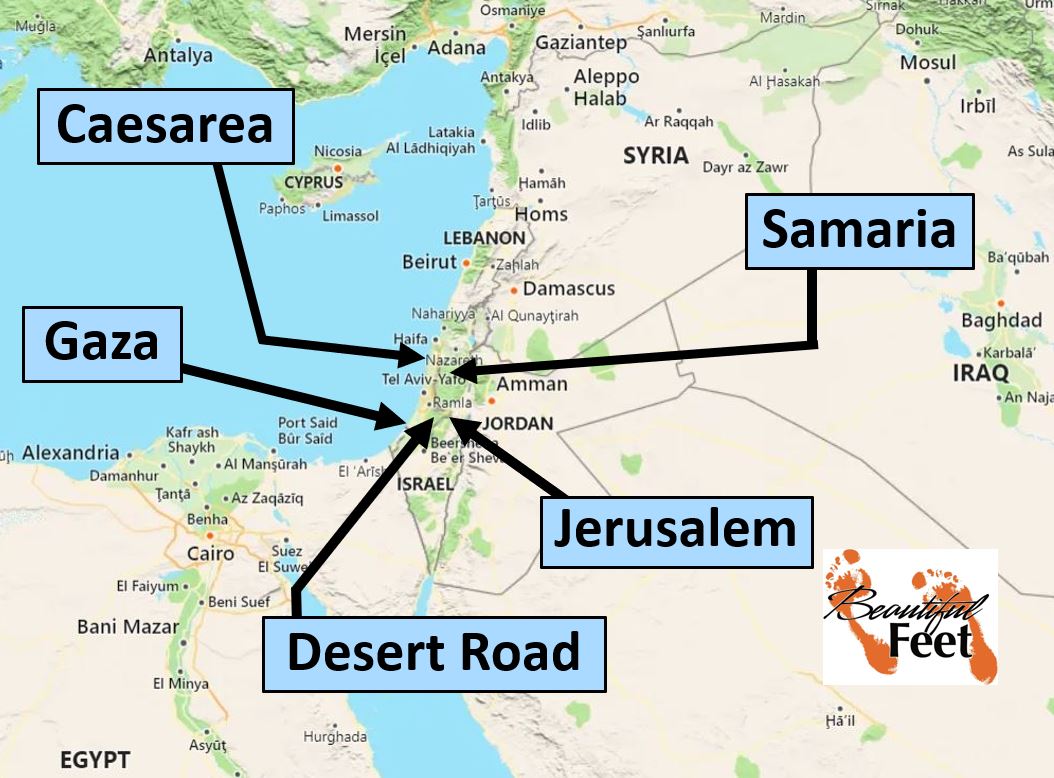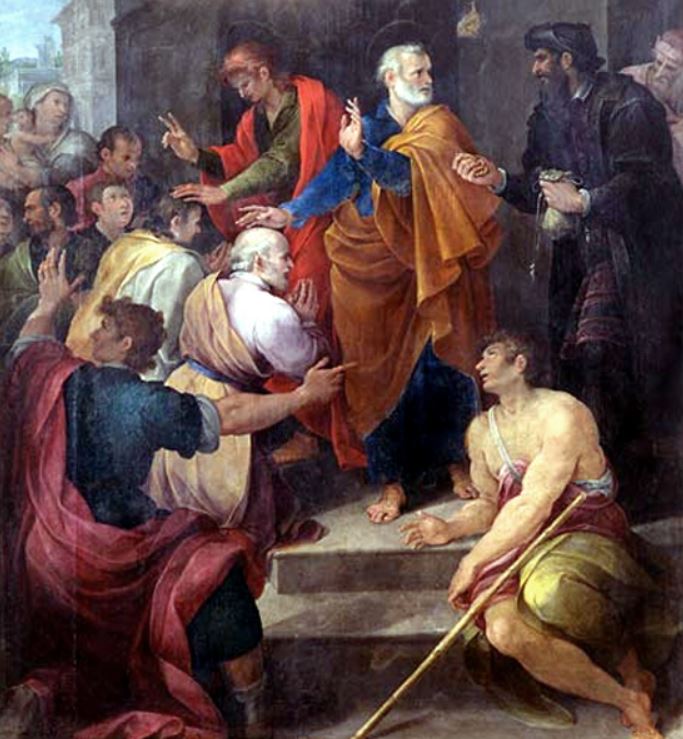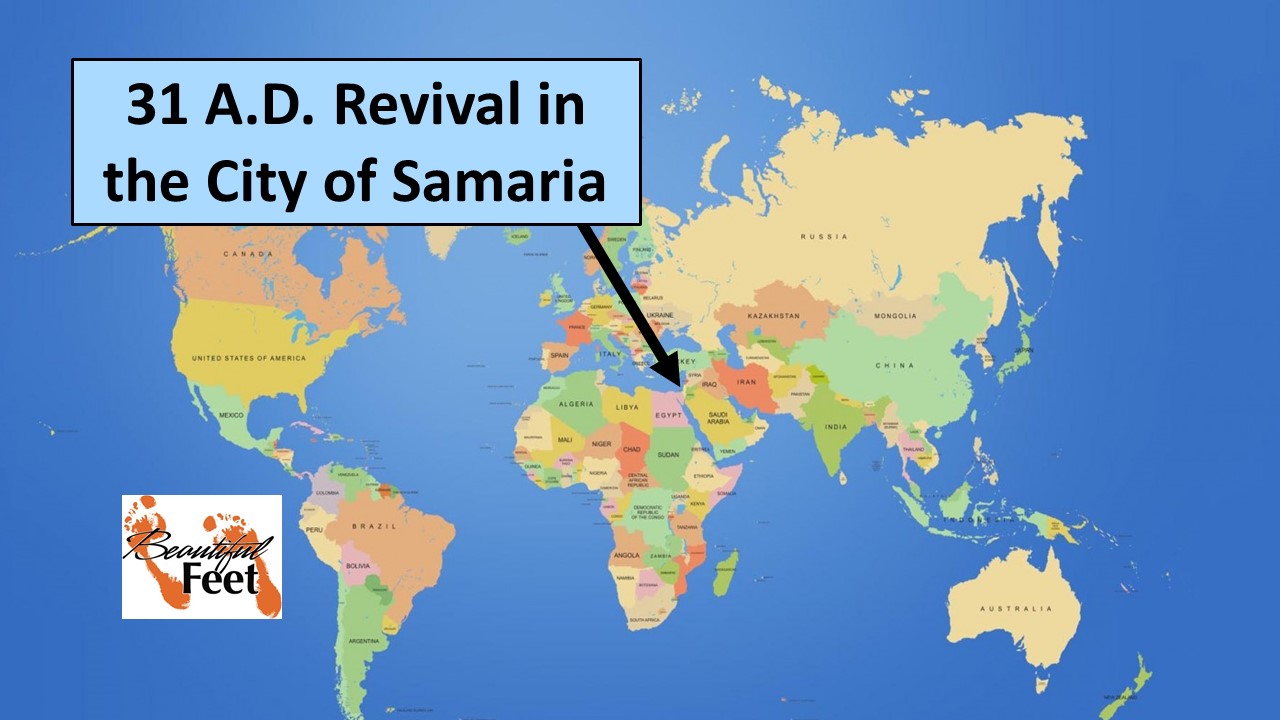

Introduction
The revival in the city of Samaria occurred about one year after the revival started on the Day of Pentecost in the city of Jerusalem (30 A.D. Revival on the Day of Pentecost). This revival in Samaria was part of the revival movement that was beginning to spread throughout the Roman empire. Though it is an unpleasant reality, persecution was instrumental in the spread of this revival (Acts 8:1-3).
Main locations in this revival account.
Revivals Have the Ability to Spread
It has been noted, on many occasions, that when a person experiences a revival there is change that occurs in that person, and they are forever transformed. The person will never again be content without a revival atmosphere pervading the congregation they attend or community they live in.
This is evidently what happened with Philip. When the persecution got intense in Jerusalem, he left his ministry to the poor in that city (Acts 6:1-6) and relocated to Samaria, and accompanying him to Samaria was the “Spirit of Revival” (Acts 8:4-5).
Samaritans Were Prepared for Philip’s Ministry
There was undoubtedly a lingering effect of the A.D. 27 Revival in the Samaritan Village of Sychar, which occurred under Jesus’ ministry. Many in that revival placed their faith in Jesus, and it is suspected that those people carried their newfound faith throughout the region, and eventually it entered the city of Samaria. Then when Philip arrived he found a people prepared for his message (Acts 8:6).
Crowds listened intently to Philip because they were eager to hear his message and see the miraculous signs he did. Many evil spirits were cast out, screaming as they left their victims. And many who had been paralyzed or lame were healed. So there was great joy in that city (Acts 8:6-8).
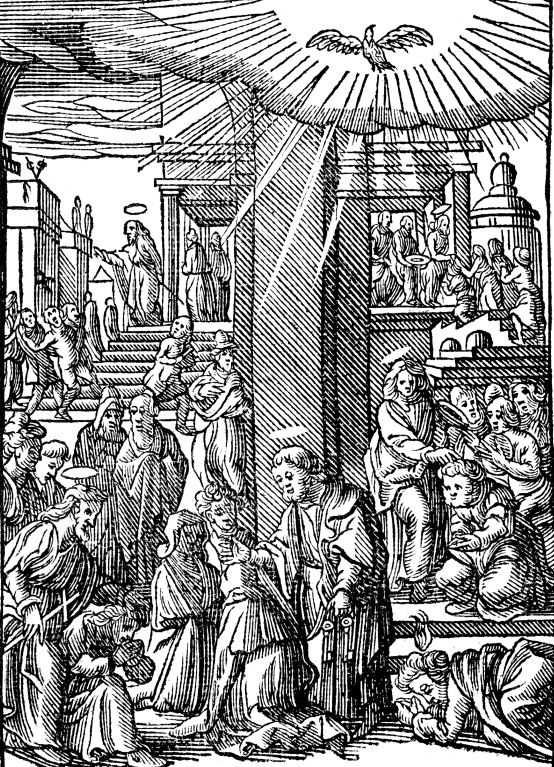
Revival in Samaria
Note what attracted the Samaritans:
► Philip’s message (Acts 8:6).
► The miraculous signs of demons being cast out, “screaming as they left their victims.” The paralyzed or lame were healed, and there were other “signs and great miracles” (Acts 8:6-7, 13).
► The joy—it was contagious—which spread throughout the city. Inexpressible and inextinguishable joy is always part of genuine revivals (Acts 8:8).
► “Many believed,” and following their renunciation of paganism, or Samaritanism, they submitted to water baptism as an outward act declaring their conversion. While others observed people making this public statement, the influence spread (Acts 8:12-13).
► One notable sorcerer (Simon) was converted and was subsequently baptized. This man had a reputation as being “the Great One—the Power of God.” When news of that man’s conversion spread, even more people were interested in Philip’s message (Acts 8:9-11, 13).
The Revival Receives More Fuel
Acts 8:12 shows us that
The people believed Philip’s message of Good News concerning the Kingdom of God and the name of Jesus Christ. As a result, many men and women were baptized (in water).
These people were genuinely born again and had already been made part of the family of God by faith, yet there was a baptism of power that was soon to come upon them (as promised by Jesus in Acts 1:8).
News of a genuine revival travels fast, and when the news reached the apostles who were at Jerusalem, “that Samaria had accepted God’s message,” they immediately sent Peter and John to investigate, as well as to participate (Acts 8:14-17).
Peter and John’s first act upon their arrival in Samaria was not to preach sermons or teach. “As soon as they arrived, they prayed for these new believers to receive the Holy Spirit” (Acts 8:15). Their prayers were immediately answered, with visible evidence being given that the baptism that Jesus had promised occurred (Acts 1:8). We don’t know what visible evidence was seen, or heard, but the evidence of speaking in unlearned languages and prophecy were commonly found in other places when the baptism of the Holy Spirit was received:
- Day of Pentecost—speaking in unlearned languages, flames of fire, sound of a windstorm (Acts 2:1-4)
- Samaritan believers—unspecified evidence, but evidence nonetheless (Acts 8:18-19)
- The apostle Paul—the Holy Spirit came upon him, but the type of evidence is not mentioned (Acts 9:17;.1 Corinthians 14:18)
- Cornelius’ household—speaking in unlearned languages (Acts 10:44-48)
- Ephesus—speaking in unlearned languages and prophesying (Acts 19:1-7)
Note that after Peter and John prayed for the believers in Samaria to receive the baptism of the Holy Spirit, they didn’t remain there. They returned to their ministry in Jerusalem but “stopped in many Samaritan villages along the way to preach the Good News” (Acts 8:25). A lesson from these two apostles is that when revival fire is falling on a particular city or location, we must do all we can to see it spread, and that means leaving the center of the revival.
Simon (in black) attempting to buy the power of the Holy Spirit – Avanzino Nucci, 1620
Distractions during Revivals
Whenever there is a revival, it doesn’t take long before Satan will be seen at work. His presence should be expected and anticipated. Those leading a revival who do not anticipate demonic influence will be quickly blindsided with all types of complications attempting to bring the revival to a rapid end (2 Corinthians 11:14). That has been the pattern in every revival.
The revival at Samaria experienced this demonic attempt, when a new convert, Simon, who was a former sorcerer, attempted to purchase the power of God that was being displayed by Peter and John (Acts 8:18-24). This has led to the term “Simony,” describing those who try to buy leadership positions or influence within a church structure.
Peter immediately spoke to Simon and corrected him: “your heart is not right with God” (Acts 8:21). Amazingly, Simon immediately demonstrated repentance and the fear of God (Acts 8:24).

Acts 8:26
Unexpected Guidance from an Angel during the Revival
What has occurred with some revivalists is seen to have happened with Philip. Right during the middle of the revival in Samaria, he is given orders from an angel to leave the revival that is in process and go to a lonely desert road (Acts 8:26).
Philip had no other directions. It would be interesting to know what was going through his mind at that time, but all we know is that he obeyed, and after traveling approximately 90 miles he encountered a “eunuch of great authority” from Ethiopia, whom he shared the Gospel with, and subsequently baptized (Acts 8:27-40).
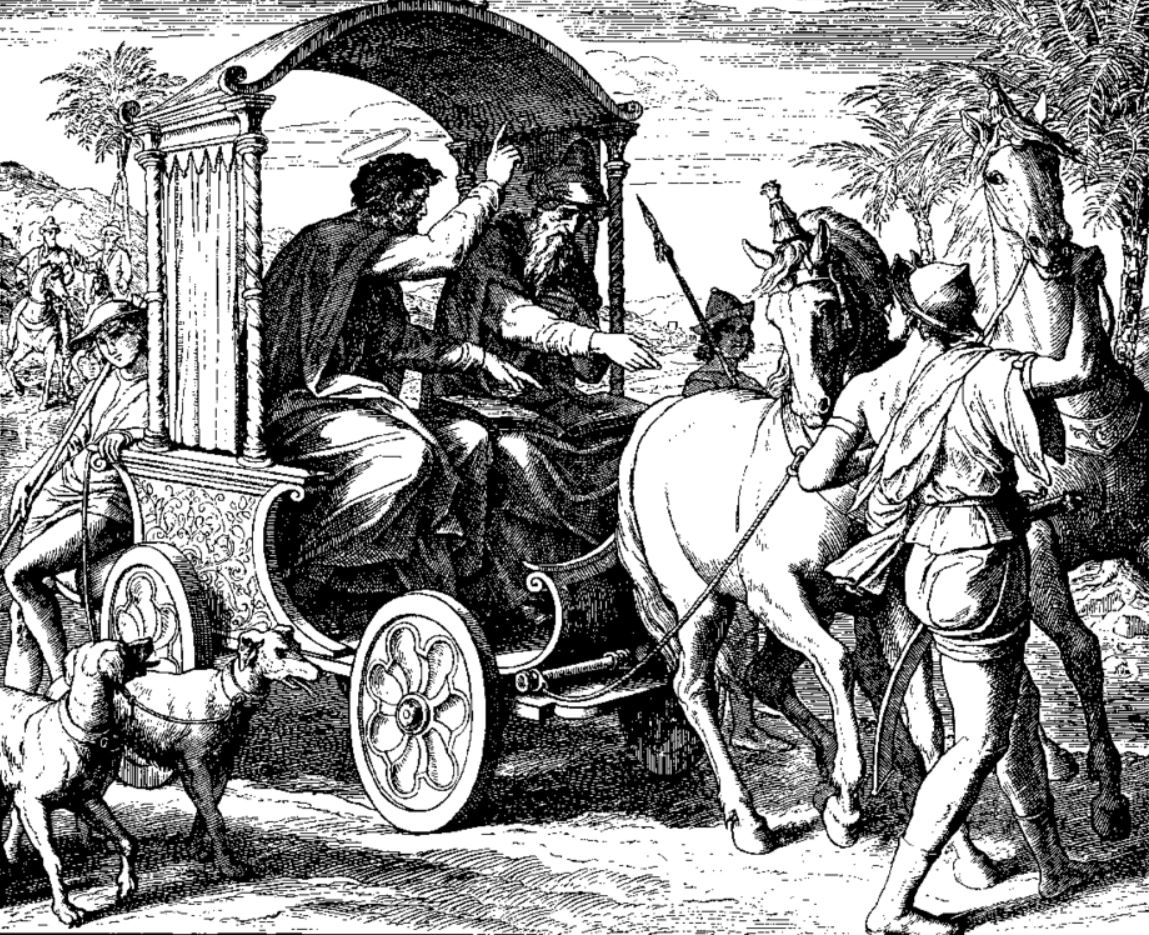
Philip and the Ethiopian eunuch on the desert road leading to Gaza
After Philip baptized the Ethiopian eunuch, he began his preaching journey along the Mediterranean coast till he reached Caesarea, preaching in every town along the way (Acts 8:40). The Bible doesn’t show if he ever returned to Samaria, but we do know Caesarea was the location where he took up residence, with his four prophetically gifted daughters (Acts 21:8-9). It was in this city that another revival commenced a few years later: 37 A.D. Revival in Caesarea.

Philip’s travels along the Mediterranean coast (Acts 8:39-40)
Lessons Learned from Philip’s Revival and Evangelistic Ministry
Philip is the only named evangelist in the New Testament (Acts 21:8). There were undoubtedly many others who were engaged in evangelistic work, but it is undeniable that Philip is the only person specifically named as having the ministry gift of evangelist (Ephesians 4:11). That being the case, it would be beneficial to review Philip’s model of ministry.
Philip’s Model of Ministry
Should Philip’s model of ministry be duplicated today? Is there a reason why it shouldn’t? Did Philip’s model follow the pattern set by Jesus and His disciples?
We saw in the revival that occurred on the Day of Pentecost, that the apostle Peter claimed that miraculous occurrences would occur till the end of time, and that those occurrences were direct manifestations of the Holy Spirit’s power, like prophecies, dreams and visions (Acts 2:17-18;.1 Corinthians 12:7-11 and Romans 12:6-8).
New Testament Pattern for Evangelism and Disciple-Making
There can be no denying that the New Testament method of conducting evangelism always involved a powerful message about God’s redeeming grace, accompanied by visible manifestation of the Holy Spirit’s power with healings, raising the dead, casting out demons, etc. That was Jesus’ model of ministry, and that is what He taught His followers to imitate. Jesus said that His model of ministry would continue till the end of the age (Matthew 28:18-20; Mark 16:15-20; Luke 24:46-49; Acts 1:8).
Here are a few biblical references that show that visible and evident manifestations of the Holy Spirit’s power accompanied the followers of Jesus as they traveled preaching the Gospel. Please note how they did not rely on words or impressive speeches. They relied on manifestations of the Holy Spirits power.
Though Jesus did speak with authority, the Scriptures are very clear that God endorsed, certified, and validated Jesus, through the miraculous signs He performed.
► Nicodemus acknowledged that Jesus was sent by God to teach them, and he added, “Your miraculous signs are the evidence that God is with you (John 3:1-2).
► “People of Israel, listen! God publicly endorsed Jesus the Nazarene by doing powerful miracles, wonders, and signs through him, as you well know” (Acts 2:22; also Acts 10:38; 17:31; John 5:36, 6:27; 14:11; John 15:24).
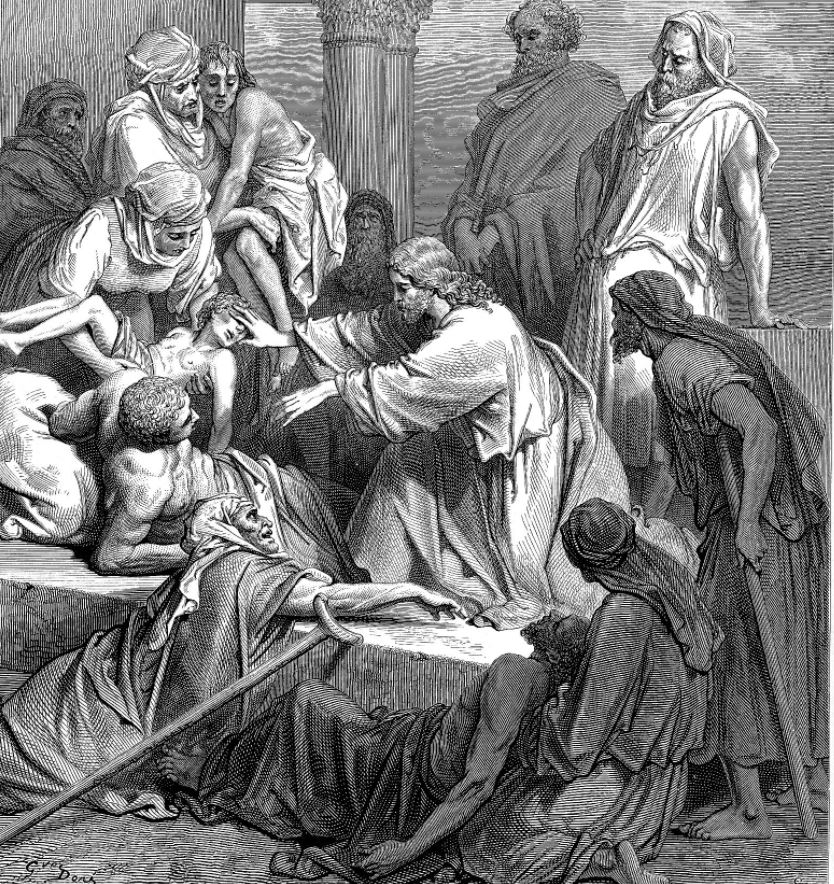
Jesus healing the sick
Following Jesus’ model of ministry, the disciples were also endorsed and certified by, and had their words confirmed through, the miraculous signs they performed.
► “And the disciples went everywhere and preached, and the Lord worked through them, confirming what they said by many miraculous signs” (Mark 16:20).
► “And God confirmed the message by giving signs and wonders and various miracles and gifts of the Holy Spirit whenever he chose” (Hebrews 2:4).
► “But you will receive power when the Holy Spirit comes upon you. And you will be my witnesses, telling people about me everywhere—in Jerusalem, throughout Judea, in Samaria, and to the ends of the earth” (Acts 1:8).
► “‘And now, O Lord, hear their threats, and give us, your servants, great boldness in preaching your word. Stretch out your hand with healing power; may miraculous signs and wonders be done through the name of your holy servant Jesus.’ After this prayer, the meeting place shook, and they were all filled with the Holy Spirit. Then they preached the word of God with boldness” (Acts 4:29-33).
► “But the apostles stayed there a long time, preaching boldly about the grace of the Lord. And the Lord proved their message was true by giving them power to do miraculous signs and wonders” (Acts 14:3)
The apostle Paul too acknowledged that it wasn’t with impressive speeches that he won people’s hearts. He said that the people were “convinced by the power of miraculous signs and wonders…” (Romans 15:19).
► “They were convinced by the power of miraculous signs and wonders and by the power of God’s Spirit. In this way, I have fully presented the Good News of Christ from Jerusalem all the way to Illyricum” (Romans 15:19;.also 1 Corinthians 2:4-5; 4:19-20; 14:12;.2 Corinthians 13:3;.1 Thessalonians 1:5; Numbers 14:17; Psalm 71:17-18; Isaiah 52:6)
Today’s Evangelistic and Revival Ministries
If Jesus, His apostles, and the apostle Paul all relied upon the convincing power of miraculous signs and wonders to confirm the words they spoke, do we believe we have no need of them today?
Return to List of Revival Stories
Chet & Phyllis Swearingen:
Office: (260) 920-8248
romans1015@outlook.com
Beautiful Feet
P.O. Box 915
Auburn, IN 46706

